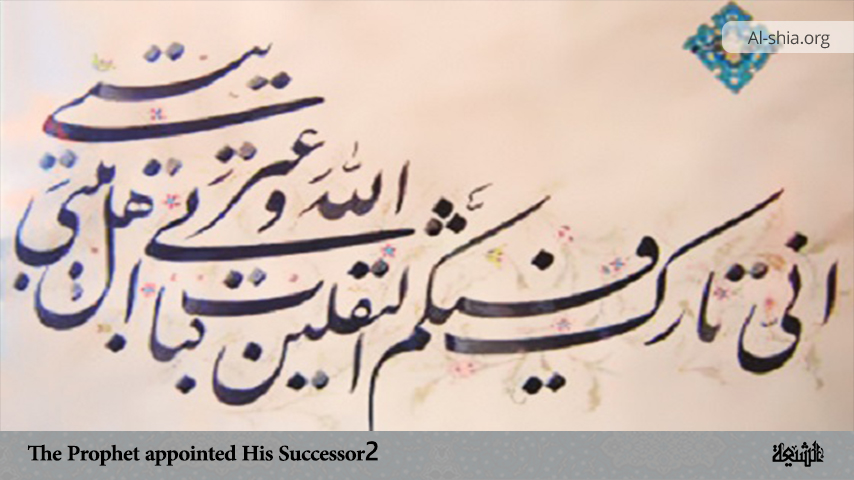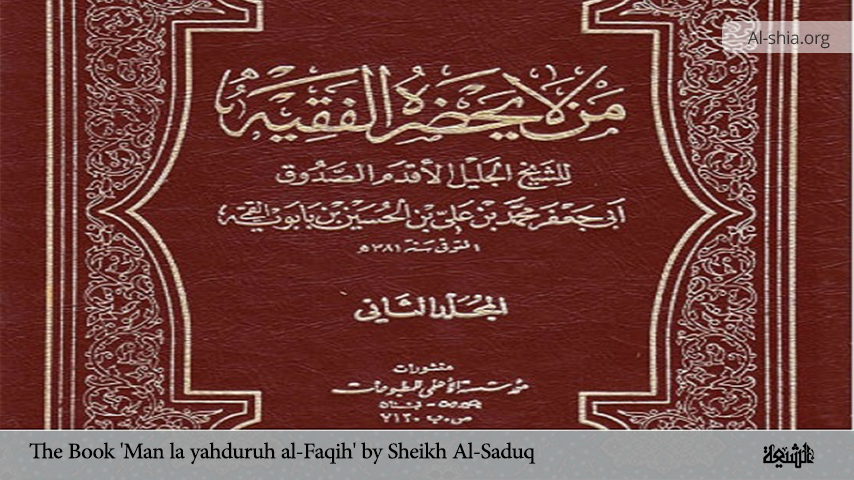In continuation of the discussion on the issue of successorship after the death of the Prophet, we shall focus in this part of the article on other textual evidence to establish the claim that the Prophet appointed a successor before he died.
Ahmad further records:
حدثنا عبد الله حدثني أبي ثنا أبو أحمد الزبيري ثنا شريك عن الركين عن القاسم بن حسان عن زيد بن ثابت قال قال رسول الله صلى الله عليه و سلم إني تارك فيكم خليفتين كتاب الله وأهل بيتي وإنهما لن يتفرقا حتى يردا على الحوض جميعا
‘Abd Allah (b. Ahmad) – my father (Ahmad b. Hanbal) – Abu Ahmad al-Zubayri – Sharik – al-Rakin – al-Qasim b. Hisan – Zayd b. Thabit: The Messenger of Allah, (PBUH&HP), said: “I AM LEAVING BEHIND AMONG YOU two khalifahs: the Book of Allah and my Ahl al-Bayt. Both shall never separate from each other until they meet me together at the Lake-Font.” (1)
Al-Arnaut again says:
حديث صحيح بشواهده دون قوله : وإنهما لن يتفرقا حتى يردا علي الحوض جميعا
The hadith is sahih through its shawahid, except his statement, “Both shall never separate from each other until they meet me together at the Lake-Font.” (2)
Imam al-Haythami (d. 807 H) too copies this report from Musnad Ahmad:
عن زيد بن ثابت قال : قال رسول الله صلى الله عليه و سلم: إني تارك فيكم خليفتين : كتاب الله عز و جل حبل ممدود ما بين السماء والأرض – أو ما بين السماء إلى الأرض – وعترتي أهل بيتي وإنهما لن يتفرقا حتى يردا علي الحوض
Narrated Zayd b. Thabit: The Messenger of Allah, (PBUH&HP), said, “I AM LEAVING BEHIND AMONG YOU two khalifahs: the Book of Allah – a rope stretching between the heaven and the earth or from the heaven to the earth – and my bloodline, my Ahl al-Bayt. Both shall never separate from each other until they meet me at the Lake Font.” (3)
And he passes this verdict:
رواه أحمد وإسناده جيد
Ahmad has narrated it and its chain is good.
It was the Prophet himself who was personally leaving behind the Qur’an and his bloodline as khalifahs among his Ummah. In fact, in one of the reports, he called them “the two khalifahs after me”, thereby fixing and restricting the Khilafah to them. In any case, both the Qur’an and his bloodline are his khalifahs, appointed by him, according to the authentic ahadith above.
Something to note at this point is that the word khalifah is both singular and plural, as submitted by Imam al-Raghib al-Isfahani (d. 501 H):
والخليفة يقال للواحد والجمع ، وهاهنا [هو] جمع ، فإن الخليفة لم يرد به آدم عليه السلام فقط ، بل أريد هو وصالحو أولاده ، فهم خلفاؤه
The word Khalifah is used to refer to a single person or to a group. Here(4), it is plural. This is because the word Khalifah (there) does not refer to Adam, (PBUHH), alone. Rather, it refers to him and the righteous ones among his offspring. So, they are His (i.e. Allah’s) Khalifahs. (5)
Therefore, it was linguistically permissible for the Prophet to refer to his bloodline as his Khalifah, to indicate that each of them was his Khalifah individually. Secondly, like in the case of Adam, the word Khalifah in the ahadith is not a reference to all the members of the bloodline indiscriminately. Rather, as stated in the other ahadith, the khalifahs among them are only twelve of their righteous ones. Each of these khalifahs stands in the Messenger’s position as the amir of the Ummah and substitutes for the latter in his command roles. So, each of them is also our amir, the amir of our Prophet over us.
The big questions then rise here:
1. How many are the khalifahs of Sunni Muslims?
2. What percentage of them were from the Prophet’s bloodline, his Ahl al-Bayt?
3. What percentage of them remained eternally inseparable from the Qur’an, as stipulated by the ahadith?
4. And what percentage of them acted for the Messenger of Allah?
Without a doubt, the Sunni khalifahs were in their dozens. Meanwhile, the khalifahs for this Ummah, according to its Prophet, are only twelve. So, it is either none of them was a Khalifah for the Ummah, or only twelve of them were. Perhaps, the worst part of it all is that none of the dozens of Sunni khalifahs – apart from Amir al-Muminin and Imam al-Hasan – was from the Prophet’s bloodline. In particular, Abu Bakr, ‘Umar, ‘Uthman, Mu’awiyah and Yazid – the primary Sunni khalifahs – were all from outside the bloodline of the Messenger. This fact singlehandedly kicks them out of the scope of the legitimate Khilafah!
Apparently, Sunni Islam itself survives upon the legitimacy of the Khilafah of Abu Bakr, ‘Umar, ‘Uthman, Mu’awiyah and Yazid at the least. Should their Khilafah – or that of any of them – collapse, the Sunni religion as a whole die with it. So, the Sunni ulama make all the desperate efforts they can and go to all desperate lengths to deny the legitimate Khilafah of the Ahl al-Bayt and uphold the patently illegitimate Khilafah of the others. It is a survival tactic for them. They have no other choice if they still want to maintain their flocks and the attendant benefits. However, it is indeed a very dangerous game actually, in light of this noble verse:
ولا تلبسوا الحق بالباطل وتكتموا الحق وأنتم تعلمون
And mix not the Truth with falsehood, nor conceal the Truth while you know.(6)
Then, Allah adds:
إن الذين يكتمون ما أنزلنا من البينات والهدى من بعد ما بيناه للناس في الكتاب أولئك يلعنهم الله ويلعنهم اللاعنون
Those who conceal the clear proofs, evidence and guidance, which We have sent down after We have made it clear for the people in the Book, they are the ones being cursed by Allah and being cursed by the cursers. (7)
In particular, these desperate Sunni ‘ulama focus upon the Khilafah of Amir al-Muminin ‘Ali b. Abi Talib. He was the immediate, undisputed leader of the Prophet’s bloodline after the latter. Meanwhile, the true Khilafah had been fixed permanently within this same bloodline. Therefore, naturally, ‘Ali was the first legitimate Khalifah of Islam. So, even if there were no other authentic ahadith about his Khilafah, it is nonetheless perfectly proven through this route.
Yet, in addition to this general evidence, there are also loads of specific undeniable Sunni proofs for the Khilafah of Amir al-Muminin over Abu Bakr and the entire Ummah after the Messenger of Allah. But, as a way of protecting the patently illegitimate Khilafah of Abu Bakr, ‘Umar and ‘Uthman, some scholars of the Ahl al-Sunnah further wage an extreme war against the authentic evidences in favour of ‘Ali in their own books. They instinctively deny, without tabling any academic excuse, any sahih Sunni hadith about Amir al-Muminin which threatens Abu Bakr and ‘Umar in any way – whether in merits, virtues or Khilafah.
None among them has ever been as violent in this regard as Shaykh Ibn Taymiyyah. He has done this recklessly and relentlessly throughout his books, especially Minhaj al-Sunnah. Therefore, in this book, this author has concentrated mainly upon Ibn Taymiyyah’s claims and arguments against the doubtless Sunni proofs which firmly, explicitly and specifically establish the Khilafah of Amir al-Muminin immediately after the Messenger of the Lord of the worlds.
In this book, we have adopted the same investigative research methodology as we did in our first book: ‘Ali: the Best of the Sahabah. Through these efforts and the complete transparency of our techniques, we hope to give every truth-seeker the full opportunity to reach the truth in a safe, honest, and intellectually charged environment, devoid of sectarian propaganda or bias. We implore Allah to forgive us all our mistakes and to accept this as a worthy act of ‘ibadah. And may Allah send His salawat and barakat upon our master, Muhammad b. ‘Abd Allah, and upon his purified bloodline.
Extracted from the book titled “On The Khilafah Of ‘Ali Over Abu Bakr” by Toyib Olawuyi.
NOTES:
_______________________________________________________________________
1. Ibid, vol. 5, p. 189, # 21697
2. Ibid
3. Nur al-Din ‘Ali b. Abi Bakr al-Haythami, Majma’ al-Zawaid (Beirut: Dar al-Fikr; 1412 H), vol. 9, p. 256, # 14957
4. under Qur’an 2:30
5. Abu al-Qasim al-Husayn b. Muhammad b. al-Mufadhdhal al-Raghib al-Isfahani, Tafsir al-Raghib al-Isfahani wa Muqadimmatuh (Kulliyat al-Adab, Jami’ah Tanta; 1st edition, 1412 H) [annotator: Dr. Muhammad ‘Abd al-‘Aziz Basyuni], vol. 1, p. 139
6. The Qur’an 2:42
7. The Qur’an 2:159

















